
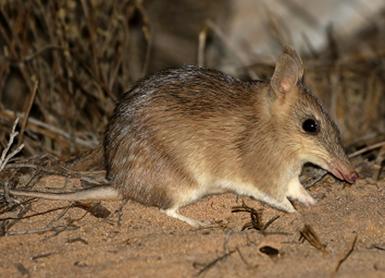

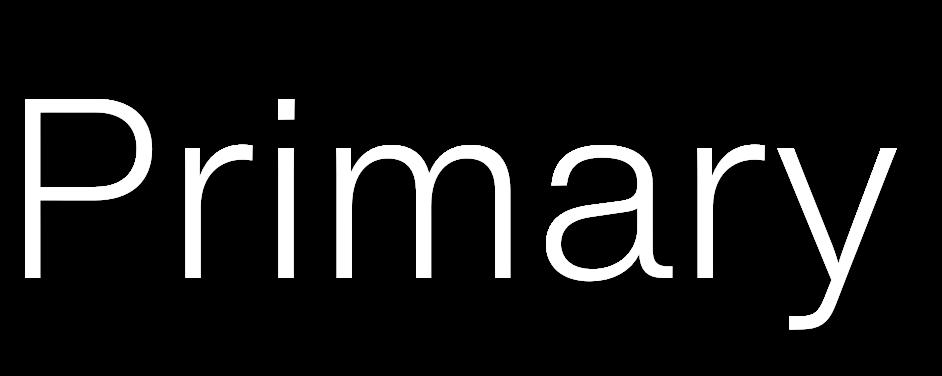
VOLUME 73 JUNE 2024

Thisjournalaimstopromotetheteachingof sciencewithafocusonclassroompractice It providesameansofcommunicationbetween teachers,consultantsandotherscience educators Opinionsexpressedinthis publicationarethoseofthevariousauthors anddonotnecessarilyrepresentthoseofthe ScienceTeachers’AssociationofWestern Australia(STAWA),theeditorialcommittee,or thepublisher
STAWAOffice Unit1/7GympieWay, Willetton,WA6155
CONTACT
Phone:(08)92441987
Email:admin@stawanet Web:wwwstawanet
EditorialCommittee
Allan Knight
John Clarke - STAWA
Lyndon Smith
Mady Colquhoun
EditorialCorrespondence admin@stawanet
GraphicDesigner
Pamela Getalado
Marketing & Communications Coordinator Contact email: admin@stawanet
AdvertisinginSCIOS
If you would like to advertise in SCIOS, please follow the link here to express your interest and submit your deliverables
©2024TheScienceTeachers’Association ofWesternAustralia(STAWA) Allrights reserved Nopartofthispublicationmaybe reproducedorcopiedinanyformorbyany meanswithoutthewrittenpermissionof STAWA Unsolicitedmaterialiswelcomedby theEditorbutnoresponsibilityistakenfor thereturnofcopyorphotographsunless specialarrangementsaremade
ISSN0157-6488
FEATURED ARTICLES
Return
TALK LIKE A SCIENTIST UPCOMING EVENTS CONASTA 71 Open
End of Term 2 Coffee Catch-Up Science Talent Search ScienceIQ STAWA Annual General Meeting (AGM)
Research News: Practical Tips for Primary Science
to 1616: Education Resource for Primary and Secondary Schools
Lab Afternoon at South Lake Primary School
SCIOS: To Know
CONTENTS CONTENTS STAWA Membership How to Contribute to SCIOS Advertising in SCIOS 1 4 6 10 12 13 14 16 18 20 WELCOMEFROMTHEEDITOR 9 15
WELCOME FROM THE EDITOR

AbouttheEditor
MadyColquhounistheChairoftheSTAWAPrimaryScienceCommittee,the CONSTAWAConvenor,SCIOSPrimaryEditorandamemberoftheSTAWA Board ShewaspreviouslyaPrimaryScienceSpecialistforover10years Currently,throughSTAWA,Madynowsupportsteachersofprimaryscience
Welcome to the second issue of SCIOS – Primary for 2024!
In response to feedback, we have reverted to the online format of SCIOS Primary However, please note this is still only a click away and is also downloadable to save for repeated reading! No logging into your STAWA account is required
We look at vocabulary for primary science with an excellent article sharing practical ways to develop students’ scientific vocabulary (originally produced in Teacher, published by ACER) and also with TALK LIKE A SCIENTIST! where we continue to explore SIS words used in primary science
The Return to 1616 Educational Resource has been developed specifically for WA students to connect with a real life example of successful restoration of an Australian environment The resources are amazing and easy to access as well as directly related to this year’s Science Week Theme: Species Survival – More than just Sustainability Perhaps this may give you inspiration for your National Science Week activities?
We hope you can join us in the two events coming up to end term 2: an Open Lab and a Coffee Catch-Up
Mady Colquhoun (SCIOS - Primary Editor)
RESEARCH NEWS: PRACTICAL TIPS FOR PRIMARY SCIENCE
Andrew Broadley (Digital Content Producer, Teacher Magazine)
ThisarticlefirstappearedinTeacher,publishedbyACER Reproducedwithkindpermission Visitwwwteachermagazinecomformore
A new report has provided 6 practical recommendations for improving primary science Drawing from international evidence and consultation with a panel of expert practitioners and academics, it provides guidance on how to make meaningful improvements to teaching In this article, we take a look at one of the 6 recommendations – developing students’ scientific vocabulary
Young children are naturally curious about the world they inhabit And, according to a report published late last year by Evidence for Learning (E4L) on Improving Primary Science, high-quality science is key in building this curiosity, helping young students find joy in understanding the world around them
However, as the report quickly outlines, ‘Like the other core subject areas of the curriculum, in science, there is a stubborn gap in achievement between students experiencing disadvantage and their classmates’
Put simply, while children of all backgrounds show an interest in science at a young age, not all attain the necessary skills or desire to progress to further STEM study The E4L report outlines 6 key recommendations to help address this:
1
Develop students’ scientific vocabulary
Encourage students to explain their thinking 2
Guide students to work scientifically 3
Relate new learning to relevant, real-world contexts 4 Use assessment to support learning and responsive teaching 5.
Strengthen science teaching through effective professional development, as part of an implementation process 6.
DEVELOPING STUDENTS’ SCIENTIFIC VOCABULARY
As outlined by the report, ‘It is crucial that early science teaching empowers all students to engage fully with science learning, equipping them with the knowledge and skills they need to access opportunities later in life.’
This includes teaching specific vocabulary to build students’ understanding. As noted by one primary teacher, ‘If they don’t have that key scientific vocabulary, and they can’t use it and have a discussion around it, then they’ll face more challenges,’ (Evidence for Learning, 2023)
The report includes this example to illustrate the challenges limited vocabulary can pose
SCIOS PRIMARY 1
Mrs Armstrong, a Year 5 teacher, has been teaching her class about states of matter The day was hot which was the ideal weather for students to observe the phenomenon of evaporation. She poured some water on the hot pavement and asked the question ‘where did the water go, and why?’ While the students are engaged in conversation and actively listening to each other, they frequently use informal and incorrect terms like ‘disappear’, ‘jump’, ‘soaked up’, ‘zapped away’ Some students have a misconception that the water is absorbed by the pavement, some state it could be a cloud but it should be visible, and many use the word ‘disappear’ to refer to evaporation and believe that the water has disappeared forever
From this example we can see that even though the students are actively engaged and curious, and some even hold a basic understanding of what is happening, without the right vocabulary they can’t further their understanding, nor accurately describe it
IDENTIFYING SCIENCE SPECIFIC VOCABULARY
Before you can explicitly teach the relevant scientific vocabulary, you need to first identify what the vocabulary is.
The report’s authors state that, ‘When deciding on which words to explicitly teach, consider the breadth of vocabulary and background knowledge needed to fully access the science being taught ’ They also note that categorising terms you may need can be helpful Figure 1 shows how words can be categorised into 4 groups
Figure 1. Types of vocabulary in science – example for ‘forces and magnets’, from Improving Primary Science. (Evidence for Learning, 2023).
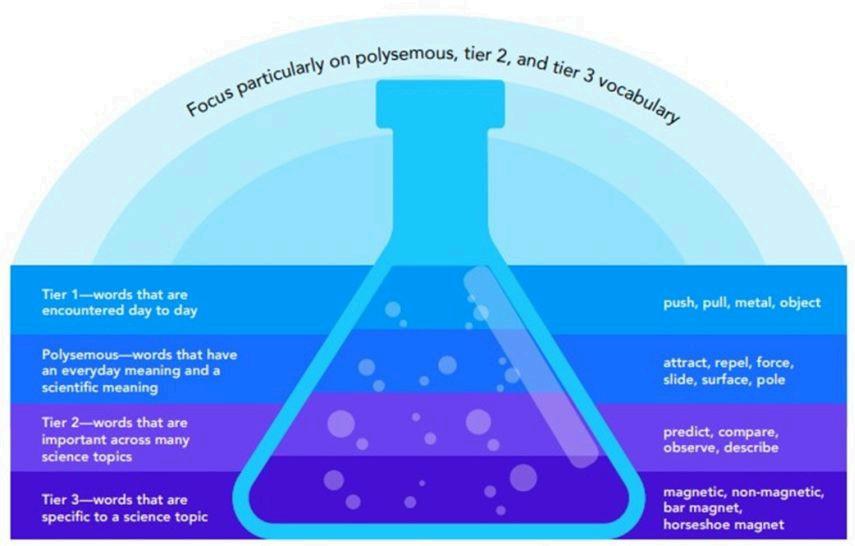
SCIOS PRIMARY 2
Whereas Tier 1 words are most easily understood, and commonly used by primary students to explain difficult concepts and topics, moving away from these words through the introduction of polysemous, tier 2, and tier 3 vocabulary is crucial for building student understanding
EXPLICITLY TEACHING NEW VOCABULARY
Once the relevant vocabulary has been identified, it must be explicitly taught in a way that is relevant to the students Otherwise, you risk reinforcing a term that, while able to be memorised and recalled, does not hold any meaning
Due to the difficulty in grasping scientific vocabulary, the report stresses the need to ‘plan when and how you will introduce new words and definitions, ensuring they link directly to the content being taught, and build on prior knowledge’ This ensures difficult vocabulary is introduced intentionally, when appropriate and when relevant Once introduced, the new vocabulary should then be repeatedly engaged with and used in different scenarios to best help students learn and understand its meaning
The report suggests these steps:
Model the use of the word in context – Provide a clear student-friendly definition or explanation This can be a good time to call upon tier 1 and polysemous words you identified earlier and that students are already familiar with
Create context for words that need to be learned – Draw on scenarios that students will already understand For example, when teaching herbivore/carnivore, consider animals students love and know, with diets they already understand (such as rabbits and lions).
Expose children to the new vocabulary across all literacy activities – Provide multiple opportunities to revisit and engage with the vocabulary This can be across other subjects and activities, such as including it in writing work, reading, and class discussions
Use vocabulary approaches that promote rich language connections – Visual aids combined with image creation (such as drawing pictures and diagrams) can also help In some cases, etymology may be beneficial, for example, highlighting the ‘herb’ in ‘herbivore’
References:
Evidence for Learning (2023) Improving Primary Science Evidence for Learning https://evidenceforlearning org au/education-evidence/guidance-reports/improving-primary-science
SCIOS PRIMARY 3
RETURN TO 1616: EDUCATION RESOURCE FOR PRIMARY AND SECONDARY SCHOOLS
Wendy Payne
WendyisacommunityengagementofficerintheScienceDirectorate–BiodiversityandConservationScienceatthe DepartmentofBiodiversity,ConservationandAttractionsandhasbeeninvolvedinthedevelopmentofresourcesfor theReturnto1616DirkHartogIslandNationalParkEcologicalRestorationProject
When teaching students about restoration of the Australian environment, finding education resources with valuable, real world examples for students to study can be a challenge It can be even more challenging to find examples that provide a positive outlook for the future The free Return to 1616 Education Resource is both real world and positive, and offers so much more for both students and teachers
The resource is based on a Department of Biodiversity, Conservations and Attractions (DBCA) project that is happening right now in Western Australia (WA) The Dirk Hartog Island National Park Return to 1616 Ecological Restoration Project is one of the most important restoration projects in Australia and of global significance
When first encountered by Europeans in 1616, the island was pristine Since that time, the introduction of feral cats, goats and sheep have degraded the island and many of its original native animals became locally extinct The Return to 1616 restoration project began in 2012 and aims to turn back the hands of time and restore the island’s ecology to something more closely resembling that seen by early explorers Since its inception, the project has made Dirk Hartog the world’s largest island to have achieved the complete eradication of feral cats, goats and sheep and is making amazing progress with native fauna reintroductions

The education resource was officially launched in 2022 at the Science Teachers Association of WA conference CONSTAWA and more recently was showcased in 2023 at the Australian Science Teachers Association, CONASTA 70 where the theme “space to innovate” allowed some of the more intriguing aspects of the resource to be displayed in a workshop including exercises using virtual reality and 3D imaging technology.
Although the Return to 1616 Education Resource was originally intended for students from Kindergarten to Year 6, it has recently been revised to include students up to Year 10 In addition, WA Year 11 and 12 geography students are now using the package to study global environmental change The education resource is also closely allied with the
SCIOS PRIMARY 4
SharkBaybandicootphoto-SteveReynolds(DBCA)
Science Teachers Association of WA’s (STAWA) material produced for Year 9 students studying ecosystems and chemistry
The resource has many exciting exercises and is vast, which can be overwhelming To assist teachers in choosing exercises appropriate for their year and subject, the package has been “salami sliced” into “bite-sized” pieces to make the resource easily accessible and user friendly Activities are divided up by subject and year level, detailing the relevant achievement standards and assessment pointers The education resource meets achievement standards in English, HASS, Technologies and Science and, to assist teachers in assessing student progress, it also provides a teacher section with Assessment Pointers up to year 10 All activities are easy to download as either PDF files or PowerPoint slides
The official home for the education resource is on Sharkbay org where more Return to 1616 background information can be found To make the resource more readily accessible to teachers Australia wide, it has also been made available on Scootle
To assist teachers and students with projects involving science as a human endeavour, the resource also contains an information hub that boasts an impressive array of study resource material including magazine articles, newsletters and key scientific publications written on the project available from the DBCA online library
With ongoing updates to keep up to date with the restoration project as it progresses, the Return to 1616 Education Resource promises to be a tremendous educational tool for years to come The project is funded by the Gorgon Barrow Island Net Conservation Benefits Fund and runs through to 2030
SCIOS PRIMARY 5
TALK LIKE A SCIENTIST!

LABELLED DIAGRAM
A labelled diagram uses one- or two-word labels to describe the object
When to use?
For example:
Body parts of an insect
Simple description of stages of a life cycle
Labelling an equipment set up
Parts of a plant
Conventions:
Words to be on the blank part of the page not on the diagram itself
Use a ruled line to link the word to the relevant part of the diagram not an arrow (arrows in science imply forces or direction)
Word to be close to the relevant part of the diagram so the line does not cross over the diagram if possible
Label in pencil for hand drawn diagrams
Label horizontally not at an angle or sideways
Label not to be underlined
Sometimes we see different but similar terms being used interchangeably or even incorrectly
Continuing our guide to help you sort out some of the commonly used terminology in primary schools
ANNOTATED DIAGRAM
An annotated diagram adds notes that provide an explanation or comment Short phrases or sentences will usually be used rather than long complex explanations
When to use?
For example:
Explaining the specific set up or how to use the equipment in a procedural diagram
Adding information to a biological sequence such as how the changes in the stages of a life cycle occur or where they are commonly found
Detailing external observations of an animal explaining adaptations
Conventions:
Comment to be on the blank part of the page not on the diagram itself
Use a ruled line to link the comment to the relevant part of the diagram not an arrow (arrows in science imply forces or direction)
Comment to be close to the relevant part of the diagram so the line does not cross over the diagram if possible
Written in pencil for hand drawn diagrams
Written horizontally not at an angle or sideways
Comment not to be underlined
SCIOS PRIMARY 6
OBSERVATIONS
This is a variable that is discussed or recorded after being seen, heard, felt, tasted (but not in a Science laboratory!) or smelt safely
Observations can be made using the five senses either directly by an individual or indirectly by a measuring device like a camera or a mobile phone
During discussions with students, clarifying and ‘fine tuning’ verbal observations will form an important preparation to written or other ways of recording observations
Types of observations:
Observations could include colour, shape, patterns, evidence of illness or damage, change of life stages, type of locomotion, growth, evidence of feeding, type or ‘strength’ of smell, volume or pitch of sound, regularity of sound, texture of a surface, ease of manipulating a material – there are so many ways to ‘observe’.
It will depend on the age of the students and the type of activity being done as well as the purpose of the activity
DATA/RESULTS
Data (plural of datum) - the measured value of a changed (independent) or measured (dependent) variable
Using measured data removes some of the bias and errors that personal observation may bring By using counting, an instrument or tool (e g ruler, thermometer, light meter) which is calibrated for consistent and accurate measurement, data can be assumed to reflect the true effect of changing a variable
Some error factors can still occur due to the person doing the measuring or the accuracy of the equipment, but this can be accounted for when designing investigations, learning to use the tool, and also clarified in the investigation evaluation
Data in primary science is usually collected in a 2 column table which indicates the changed variable and the measured variable in separate columns The table may be fully provided for younger students while older students would be expected to progress to self-construction of tables See PriSci Pin-Up Constructing tables and graphs in primary science Part 1
SCIOS PRIMARY 7
OBSERVATIONS
When might making observations be used:
Describing the effects of using force to manipulate play dough
Talking about how an object rolls then drawing a (labelled or annotated) diagram to show this
Drawing or photographing the germination of seedlings over a few days and annotating or labelling the stages
Recording different habitats in the school yard including the types of invertebrates found living there
Identifying different smells from the leaves of native plants growing around the school
Listening for and recording, describing, or classifying bird sounds at school
Describing how a plant looks after it has been watered with salt water for 2 weeks
Both labelled and annotated diagrams are useful when making and recording observations
Observations can also be referred to as qualitative data
DATA/RESULTS
When might collecting data be used:
Using a ruler, tape measure or other linear measuring tool to see how far a car rolls down a ramp
Using a thermometer to record the effectiveness of different insulation materials in keeping hot water warm over an hour
Timing how long a liquid takes to run down a slope to explore viscosity
Counting how many times a ball bounces on different surfaces when dropped from the same height
Measuring the length of a shadow at different times of the day
Weighing chicks to record their growth over a week
Diagrams are not usually used to record data in Fair Test investigations They can be used to assist displaying data in some other types of activities or investigations
Data and results can also be referred to as quantitative data
Sometimes it can be a challenge to decide the best way to collect the results of an investigation - should it be by observations, or will it be better or even possible to collect data? The age of the students will be a guide, as well as the measuring tools available If you want a graph to be constructed then observations will not be sufficient – you will need data to construct a graph
The type of data your students collect will determine the type of graph they are able to construct See PriSci Pin-Up Constructing tables and graphs in primary science: Part 2
SCIOS PRIMARY 8
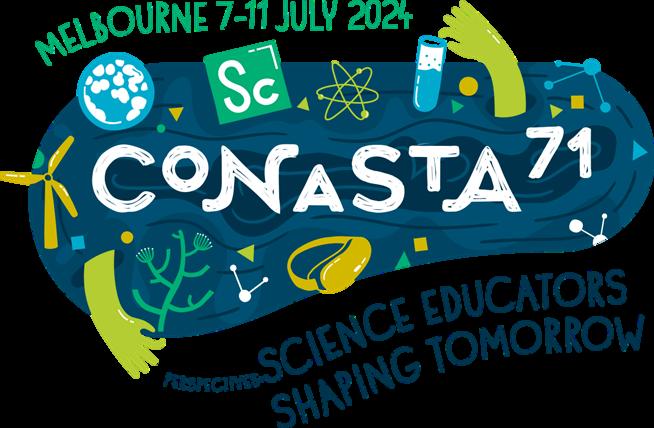
CONASTA 71 in Melbourne
The Science Teachers Association of Victoria (STAV) is excited to be hosting CONASTA 71 at The University of Melbourne, Parkville from Sun. 7 - Thurs. 11 July 2024 with the theme Perspectives: Science Educators Shaping Tomorrow
CONASTA has a strong reputation for offering high quality and stimulating professional learning experiences for science teachers, school laboratory technicians/managers and others with an interest in science education There are also a range of exciting social functions on offer Register for CONASTA by scanning the QR code below or by following the link here

SCIOS PRIMARY 9


OPEN LAB AFTERNOONS

The STAWA Primary Science Committee is excited to announce an Open Lab afternoon at on
South Lake Primary School
Wednesday, 19th June (3:30 pm - 4:45 pm)
This opportunity is kindly offered by
Robyn Matthews
This is a great opportunity for Primary Science Specialists to see how others operate either in their purpose-built laboratory or a repurposed room. Of course it is a great opportunity to network too.
You are welcome to drop in anytime between the hours listed above. Please note - no afternoon tea is provided, and all attendees are reminded that no food or drinks are allowed to be consumed in science laboratories.
Would you like to offer your lab to be part of this program? Let us know We hope to offer an Open Lab session each term. We need both NOR and SOR labs! As the host or an attendee, you are able to use these sessions for PL records.
SCIOS PRIMARY 10


OPEN LAB AFTERNOONS

EVENT OVERVIEW
After 11 years in a high school Science classroom, Robyn has embarked on the journey of primary school science specialist and she'd love to invite Primary Science teachers to an open classroom afternoon to connect and share ideas. Attendees are able to browse the equipment area and how she has set up the room, and check out the new play spaces she had set up after an informative session on "The Science of Play" at the recent CONSTAWA event.
There will be some student work book samples of various grades if attendees are into some 'light moderation' (they have done Biology for 1.5 terms and this is what grading will be on), and theycan check out how she has decided to tackle grading this semester She is open to suggestions and/or ideas on how to make the room more efficient and user-friendly - as she is still finding her way in the role.
Attendees must bring a USB if they would like a quick access to any assessment grids/programs/resources that she has created, or happy to email them to you.
So, grab a take away coffee or tea on the way (there's a nearby Muzz Buzz in South Lake) and let's enjoy a casual meet up to share ideas on this wild ride of a job!
SCIOS PRIMARY 11


The STAWA Primary Science Committee invites you to the
ENDOFTERM2COFFEECATCH-UP
happening on Tuesday, 25th of June at San
Churro's Cockburn Central
Drop in anytime from 3:30 pm.
Meet other science teachers and the STAWA Primary Committee Let us know how we can help you.
New to teaching primary science?
This is a great networking opportunity to connect with other primary science teachers.
Come and say Hi!
12 SCIOS PRIMARY
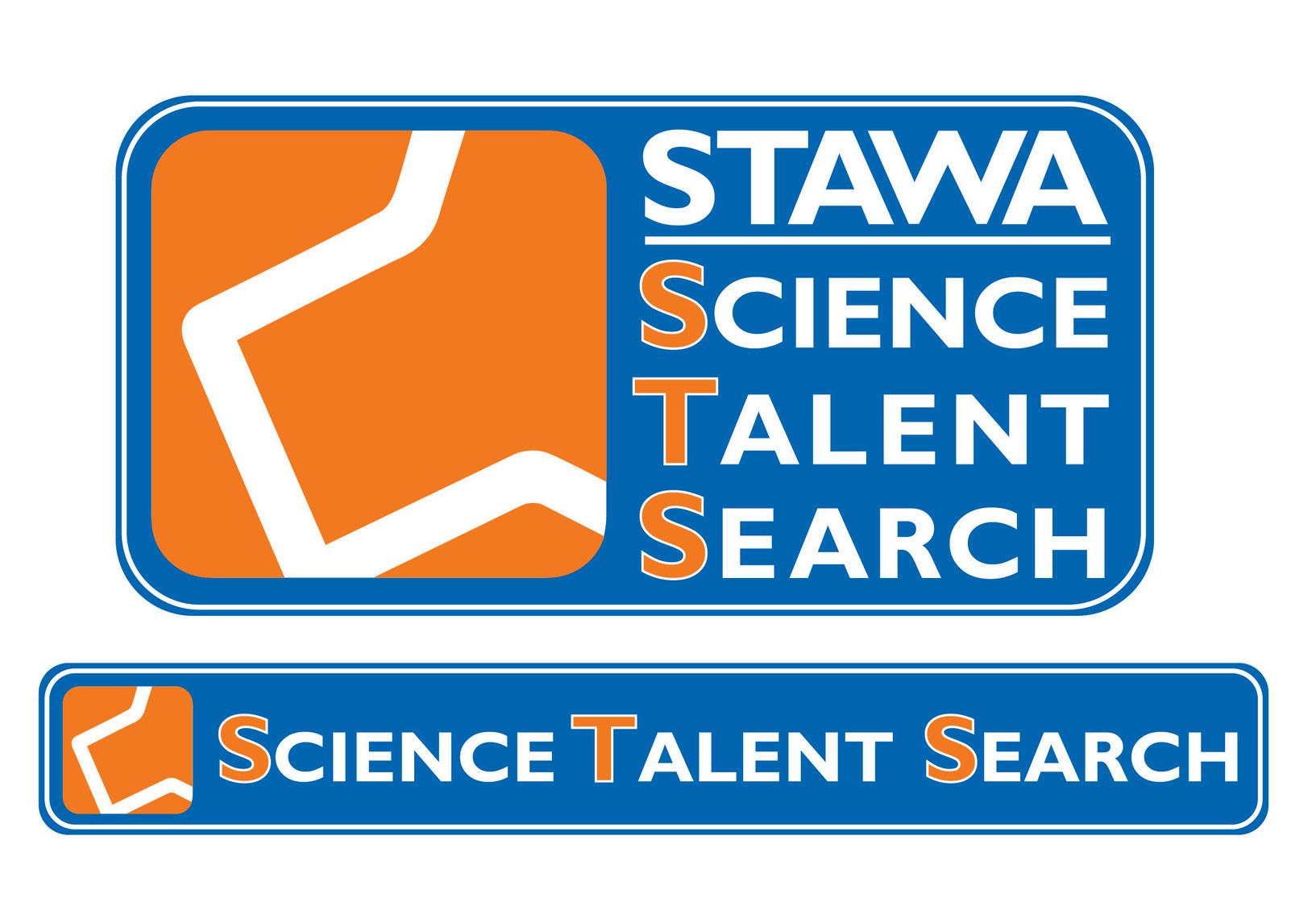
School Registrations for the 2024 Science Talent Search are STILL OPEN!
Register here
SCHOOL REGISTRATIONS CLOSE ON MONDAY, 22ND JULY 2024.
WHAT IS THE SCIENCE TALENT SEARCH?
An amazing opportunity for your students to do their own real science
WHO IS IT FOR?
Students from Kindergarten to Year 12 can enter, though different categories have some specific age requirements Make sure you check the rules for each category
CAN GROUPS OF STUDENTS ENTER?
Yes-besuretochecktherequirements.
WHATCATEGORIESARETHERE?
ScienceInvestigations
ScienceCommunication-includingposters,videos andphotography
Engineering
HOWMANYCATEGORIESCANMYSCHOOLSUBMIT?
Therearerequirementsforschoolstoprovideteachers tojudgeentriesoveracertainnumberofstudent entrants,sobesuretocheckthisoutveryearly.
WHERECANIFINDMOREINFORMATION?
LookundertheStudentActivitiestabontheSTAWAwebsite whereallyourquestionswillbeanswered.
NEVERBEENINVOLVEDWITHSTS?
Whynothaveagothisyear?Perhapsstartwithjusta fewstudententriesandlearnhowitallhappens
13 SCIOS PRIMARY

Website: https://scienceiq net
ScienceIQ is an online science quiz for school teams of four students
Teams have one hour to complete up to 12 science questions and problems in two separate rounds of competition Each round is a week apart and teachers choose the days and time to do each quiz To win, students will need to finish in the shortest time with the most questions correct
Participation certificates, first, second and third place prizes, and other great stuff
TERM 3
Years 6 and 9
Rd 1 week of 12 Aug
Rd 2 week of 19 Aug
TERM 4
Year 8 and a joint Years 5 & 6 competition
Rd 1 week of 4 Nov
Rd 2 week of 11 Nov
Registration fee:
$25 (+ GST) per year group per school
ScienceIQ will test student skills and understandings of the Natural Sciences: astronomy, physics, chemistry, Earth science, and biology
Register via the STAWA website.
Log-in details and instructions to access the practice quiz will be sent to the teachers of the registered schools prior to the competition date

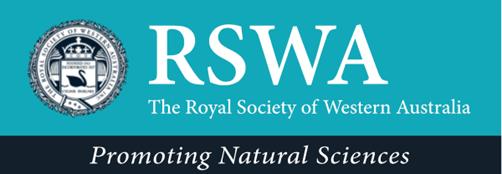
14 SCIOS PRIMARY

15 SCIOS PRIMARY ANNUAL GENERAL MEETING SAVE THE DATE! Moredetailsaboutthiseventwillberevealedsoon. Thursday, 3 October 2024

MEMBERSHIP INFORMATION
Here are just some of the benefits and opportunities for STAWA Members Please check our website for details, and to find out what else STAWA does - PLUS what STAWA can offer you! (www stawa net)
SERVICES AND SUPPORT Resources
A range of resources for both Primary and Secondary teachers is available on the website Look for the Resources Tab There are resources available to members and non-members. Members can also share resources through the STAWA website. You can download resources directly from the website or request to upload resources by contacting the Office (admin@stawa.net).
Catalist (Secondary teachers)
Catalist is an email communications list which reaches over 800 Science Educators and is used to share information, ask questions, and discuss current issues To subscribe to Catalist, look under the Teachers Tab on the website
Australian Science Teachers’ Association (ASTA) Affiliation
Full fee-paying members enjoy the benefits of affiliated membership to the national association This includes access to ASTA’s online journal, Teaching Science, and the Chrysalis online learning community
PUBLICATIONS
STAWA Members receive:
SCIOS (STAWA online journal)
STAWA SPARKs! (Primary Science Committee online publication)
Teaching Science (ASTA journal),
Spotlight on STAWA (e-newsletter)
Information about Science activities for students and teachers
Professional Development & Conference programs
SCIOS PRIMARY 16
MEMBER DISCOUNTS
Members receive discounts for STAWA Professional Development Workshops, a range of services and attractions, STAWA texts and resources, plus attendance at STAWA Conferences and events, including:
CONSTAWA (WA Science Educators Conference)
Future Science (WA Science Educators Conference)
Psychology Teachers Convention
Marine and Maritime Teachers Convention
CONASTA (Australian Science Educators Conference, ASTA)
PROFESSIONAL RECOGNITION
STAWA recognition of teacher achievement and service through annual awards –de Laeter Medal
Jeff Cahill Early Career Teacher Award
Support for primary Science teachers is given through the STAWA Early Career Primary Science Scholarship
OPPORTUNITIES
Teaching employment opportunities, curriculum review and development, government policy input, science equipment advice and professional development. An independent voice through STAWA’s representatives on many education bodies and committees.
WELCOME PACK
New members receive a Welcome Pack containing a Members USB, Pen, and Notepad
STAWA LIFE MEMBERSHIP
Each nomination for STAWA Life Membership is considered on its individual merits Nominations, accompanied by relevant supportive evidence, must be submitted to the President of STAWA Life Membership, if awarded, is bestowed at the AGM Please refer to the specific details on the STAWA website
STUDENT OPPORTUNITIES
Science Talent Search
Physics Day
Synergy Schools Solar Challenge
MEMBERSHIP QUERIES
If you have any queries with regards to your membership, please email us at admin@stawa net
SCIOS PRIMARY 17

HOW TO CONTRIBUTE?
CAN YOU CONTRIBUTE TO SCIOS?
YES, of course you can Contributions from teachers, laboratory technicians, students, academics and industry are all welcome
We are keen to increase the number and variety of types of articles published in the SCIOS So, if the answer is YES to any of the following questions, please consider submitting an article to the editor
Have you recently conducted an experiment (investigation or hands-on activity) that worked well?
Is there a great demonstration that always gets your students’ attention?
Have you tried a new teaching technique that really engaged your students?
Do you have some helpful hints for new (and not-so-new) teachers?
Are there some safety hints and tips that you would like to pass on?
Are you using some new technology that has improved the effectiveness of your students’ learning?
Are your students involved in a science project outside of school?
Have you recently attended a useful/interesting professional development activity?
Email your contributions to admin@stawa.net.
GUIDELINES FOR AUTHORS
These notes are a brief guide to contributors who should also refer to recent issues of the journal for guidance with style
Longer articles - should not normally exceed 3000 words plus figures, tables and any references Please use headings and sub-headings to give your article structure
Shorter articles - We also welcome shorter articles of approximately 500-1000 words plus figures, tables and any references Again, use of headings and subheadings may assist to give your article structure
SCIOS PRIMARY 18
Send the following to the editor:
1
Please send your document as a word file with photographs and other images embedded where you need them to be
2
3.
Photographs and other images (e g diagrams) should be sent as separate files
Photographs often increase the clarity and interest level of your work Send your photographs as tiff or highest quality jpeg files with a resolution of at least 300 dot per inch (dpi) Note to teachers: a signed parent permission slip must be obtained for any photographs of students to be included in SCIOS.
4.
Copyright for any part of your contribution that is copyright of a third party needs to be obtained in writing (email acceptable)
COPYRIGHT
No other publisher should have published your manuscript, nor should you submit for publication elsewhere If SCIOS publishes your manuscript then your text and graphics will become copyright of STAWA STAWA will, however, agree to your use of the contents of your paper for most reasonable non-commercial purposes
Contact admin@stawa net to submit your articles
19
SCIOS PRIMARY

We are currently trialing the new format of SCIOS targeted to Primary and Secondary Teachers
If you are interested to advertise for SCIOS, please follow the link here to submit your interest and the deliverables
20 SCIOS PRIMARY
ADVERTISING IN SCIOS
A4 Full page $50 + GST ADVERTISING PRICES A5 or 1/2 page $25 + GST A6 or 1/3 page FREE




















